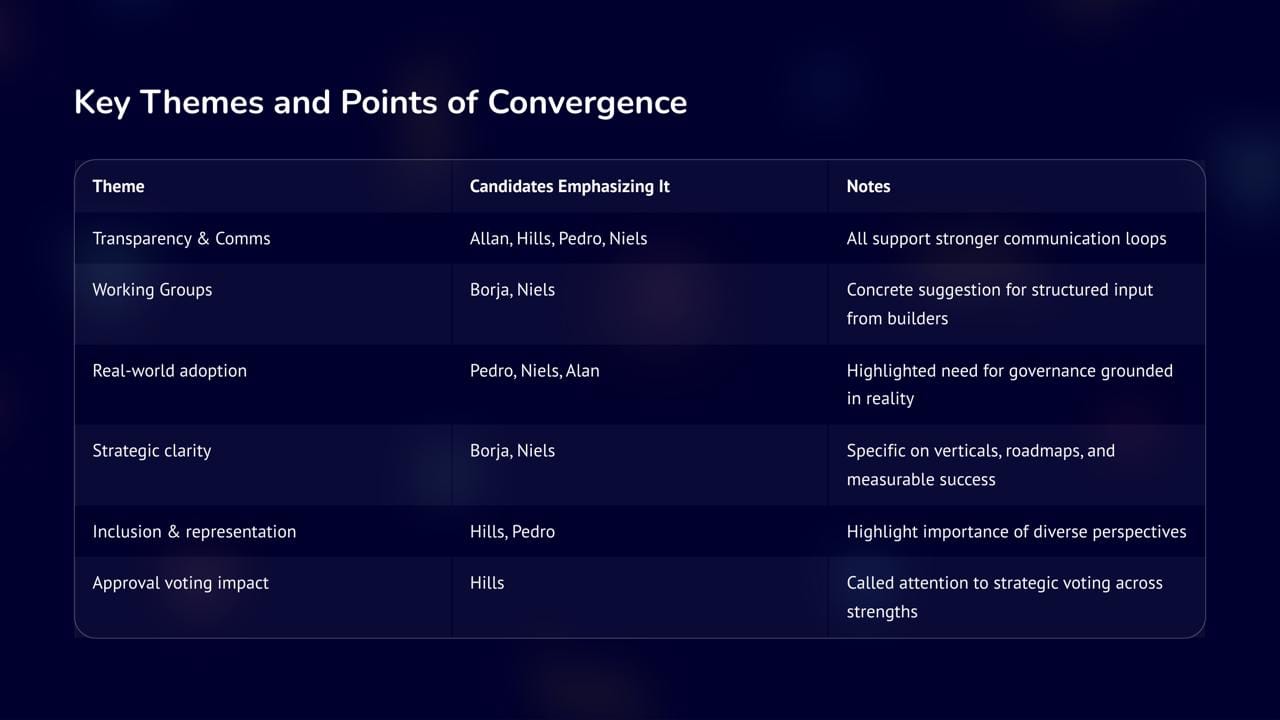Governance Committee Candidates Forum
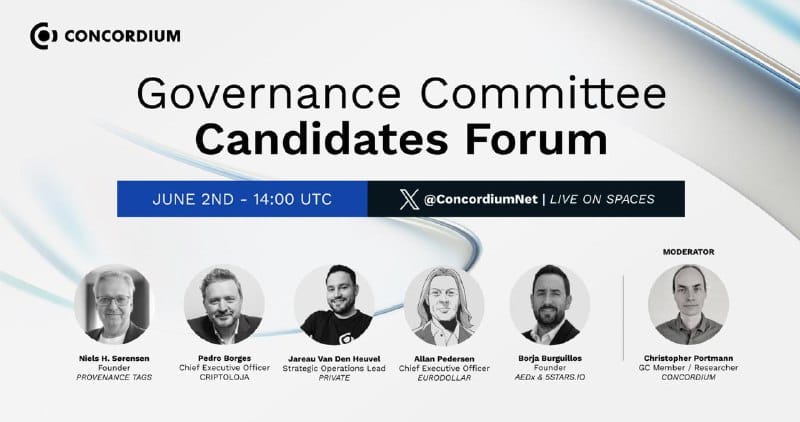
On June 2nd, 2025, five candidates - Pedro Borges, Jareau Van Den Heuvel, Allan Pedersen, Borja Burguillos, and Niels H. Sørensen - joined a live Governance Committee Election Forum on X Spaces. Moderated by current GC member Christopher Portmann, the discussion offered a rare look into how these aspiring committee members think about Concordium’s trajectory.
The conversation ranged from tokenomics and protocol evolution to decentralized governance strategy and community engagement. Each candidate brought a unique lens, whether grounded in regulation, infrastructure, product building, or community representation.
1 CANDIDATE INTRODUCTION
Before diving into policy views, it’s important to understand who the candidates are. The following summaries highlight each individual’s background, motivation for joining the Governance Committee, and the unique experience they would contribute. From seasoned finance professionals to grassroots community advocates, the field reflects Concordium’s growing diversity.
1.1 Borja Burguillos, Founder, 5Stars.io & AEDX
- Product Builder & Web3 Strategist
- 15+ years of experience in strategy , innovation , and digital product development.
- Transitioned from Web2 to full-time Web3 builder in 2020, focusing on products that bridge traditional users into decentralized ecosystems.
- Current Projects:
- 5Stars.io : AI-powered Web3 fantasy sports prediction platform that engages football fans in real-time and rewards their knowledge.
- AEDX : AED-pegged stablecoin initiative in the UAE, aiming to promote financial inclusion and reinvest profits into public goods.
- Chose Concordium for its compliance-first architecture, identity layer, and real-world use case alignment.
- Running for the Governance Committee to amplify the voice of active builders—those scaling applications and driving adoption.
- Vision: Position Concordium as the go-to chain for real adoption, sustainable innovation, and responsible growth.
1.2 Pedro Borges, CEO & Co-Founder, Criptoloja
- 28+ years in finance across Spain, the UK, Brazil, and Portugal.
- Discovered Bitcoin and blockchain while working in Brazil (2013–2018).
- On returning to Portugal, co-founded Criptoloja, the country’s first regulated crypto exchange, licensed by the Portuguese Central Bank.
- Career background in investment banking and sales, not compliance—yet now works closely with regulators and has gained deep knowledge of MiCA.
- Warns that the Travel Rule under MiCA will be a “nightmare” for exchanges, especially small ones.
- Believes Concordium’s identity layer positions it as a vital enabler for MiCA-era compliance and exchange-to-exchange transparency.
- Running for the Governance Committee to bring firsthand regulatory experience and a pragmatic, real-world perspective to the table.
- Outlook: Concordium has a crucial role to play in the post-MiCA compliance stack.
1.3 Jareau van den Heuvel (“Hills”), Community Veteran
- Entered the ecosystem as a casual investor but “stayed for the mission” — became a passionate community contributor, shilling on X, answering questions, and promoting Concordium for years.
- Not a developer, validator, or technical expert—and views that as a strength. The GC already has technical minds; what’s missing is a voice for everyday users navigating real-world complexity.
- Believes Concordium is entering a defining phase under new leadership and wants to actively contribute to its success—not just cheer from the sidelines.
- Prioritise long-term thinking, clear communication, and grounded governance that doesn’t overreact to market noise.
- Professionally, has held leadership and advisory roles in both the public and private sectors, focusing on motivating teams and translating strategy into results.
- Running to help shape a collaborative and user-aware Governance Committee—one that listens, connects, and stays focused on adoption and outcomes.
- Motto: No flashy promises—just dedication to the project and its people.
1.4 Allan Pedersen, CEO Eurodollar
- 25+ years in financial services, with a focus on private equity and fintech across Asia Pacific and Scandinavia.
- Founded and ran a private equity firm out of Singapore, investing in banks, insurance, and financial innovation.
- Built multiple fintech startups, including an insurance company in Scandinavia and ventures in China and Singapore.
- Entered crypto via MakerDAO, where he helped design and launch the first structure allowing backing funds to be invested in real-world assets (RWA)—managing $1–1.5B in U.S. Treasuries.
- Currently leading Eurodollar, the first Danish EMI-licensed stablecoin issuer, launching both USD and EUR stablecoins.
- Chose Concordium as launch partner due to its zero-knowledge proofs, compliance focus, and infrastructure readiness.
- Running for the Governance Committee to support the growth of regulated stablecoin use cases and bring a deep TradFi perspective to Concordium’s PayFi era.
- Mission: Help bridge DeFi and institutional finance by focusing on real deployment, not just theoretical promise.
1.5 Niels Sørensen CEO & Co-founder Provenance Tags
- Co-founder of Provenance Tags, a Concordium-based platform launched in 2022 focused on real-world traceability, compliance, and authentication across industries like wine, pharmaceuticals, art, and logistics.
- Provenance Tags has:
- Processed over 50 million transactions
- Minted more than 1 million NFTs
- Delivered tangible use cases in regulated and high-value supply chains
- The platform uses tamper-proof tags secured by Concordium’s identity-enabled, privacy-first blockchain to verify product origin and integrity.
- Recently expanded into programmable e-fulfillment, combining:
- Stablecoin-based payments
- Yield generation during transit
- ZKP-based identity verification
- These features are directly tied to Provenance Tags’ infrastructure and immutably logged on Concordium.
- In parallel, Provenance Tags operates a Top 50 validator node, contributes to DevNet testing, and supports protocol development—blending commercial deployment with active technical stewardship.
1.6 Comparison Matrix
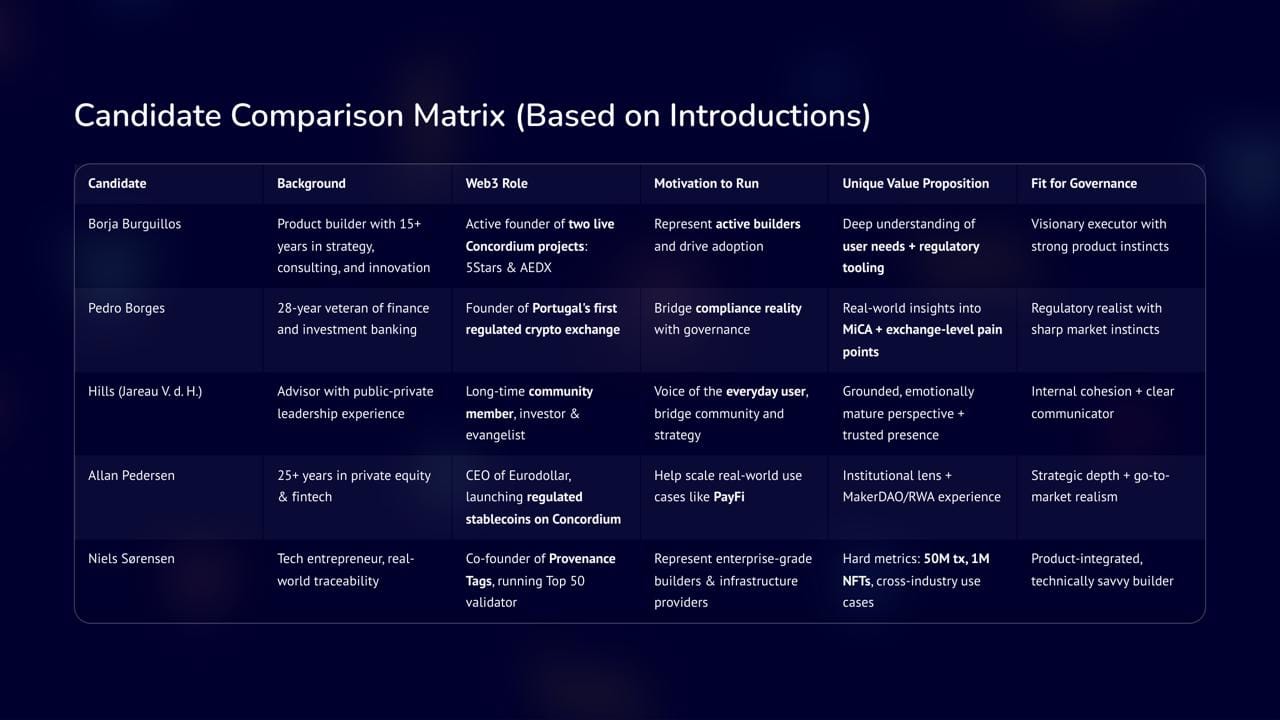
1.7 One-Liners
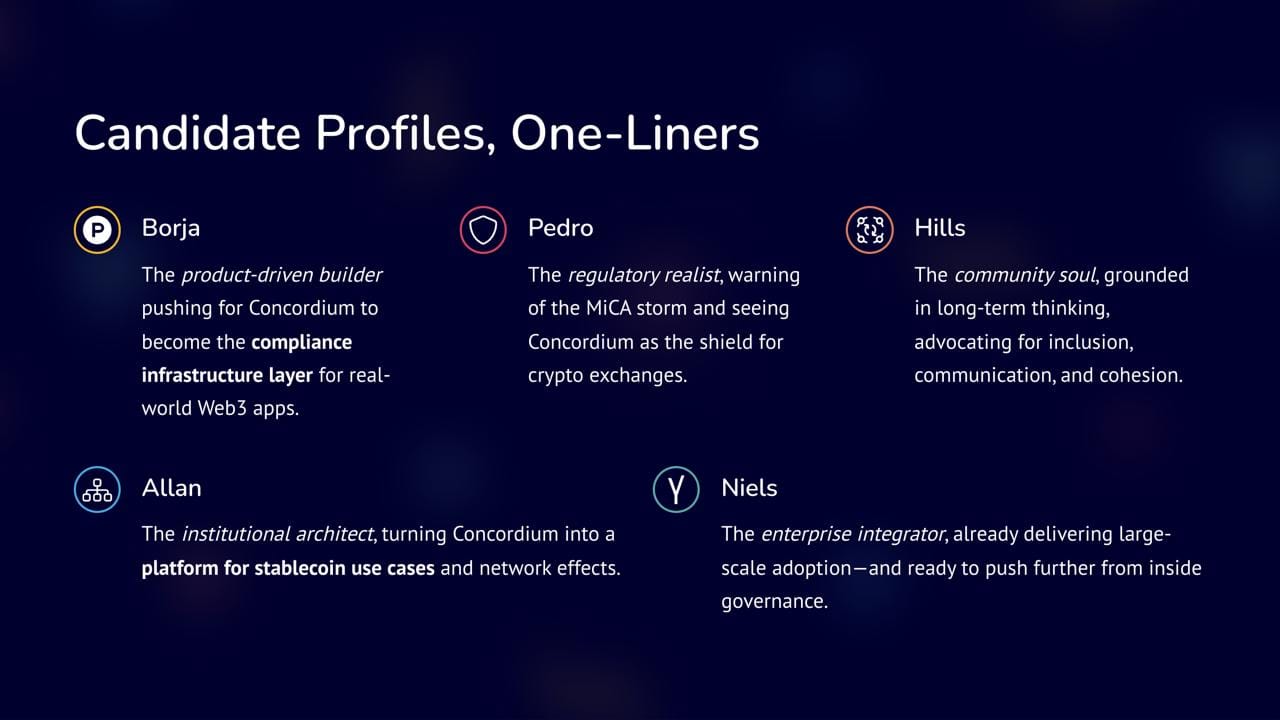
2 CORE PROTOCOL VISION
In this section, candidates offer their perspectives on the protocol’s strategic direction. The focus is not on technical tweaks, but on how Concordium should evolve to meet its mission. Should it double down on compliance? Prioritize adoption through real-world use cases? Expand native functionality? These positions reveal what kind of infrastructure each candidate believes the protocol must provide—and what success looks like.
2.1 Pedro Borges, CEO & Co-Founder, Criptoloja
- Pedro Borges, MiCA is coming, and Concordium is uniquely prepared
- Pedro highlights the imminent challenges of MiCA, especially the Travel Rule, which mandates detailed sender/receiver identity with every exchange transaction.
- Explains how even small exchanges will be burdened with costly integrations for KYC data exchange between VASPs—a nightmare for compliance.
- Predicts that private wallet transfers may soon be curtailed or heavily restricted under MiCA.
- Points out that Concordium’s identity layer already embeds much of this infrastructure, making it a natural compliance partner for exchanges.
- Though the Governance Committee doesn’t build product, Pedro believes it’s crucial they understand these dynamics to guide policy and adoption.
- Conclusion: Concordium can be the compliance rail for the MiCA era—“all the work is already done.”
2.2 Jareau van den Heuvel (“Hills”), Community Veteran
- Hills emphasizes that Concordium is entering a defining phase, with new leadership and a clear strategic shift already underway.
- Argues against rushing protocol changes or introducing new features—what’s needed now is alignment, patience, and discipline.
- Believes the Governance Committee must focus on timing and communication, ensuring the community understands where Concordium is going and can engage meaningfully.
- Suggests implementing regular structured updates, even brief ones, to foster trust and shared ownership in the transition.
- Supports the emerging single-coin narrative and PLT (Protocol-Level Token) direction, calling for space to let these ideas mature based on data.
- Calls for a GC that avoids impulsive decisions and instead offers measured, data-driven guidance.
- Sees his role as bringing calm, clarity, and community connection—not personal agendas.
2.3 Allan Pedersen, CEO Eurodollar
- Allan refrains from commenting on technical protocol tweaks and focuses on real-world application as the path to growth.
- He believes Concordium must prioritize attracting a “zero-to-one” use case, so deploying one or a few strong projects (e.g., neobanks, trade finance) that prove product-market fit.
- Argues that successful early deployments will naturally unlock network effects, creating stickiness and attracting others.
- Urges the GC and core team to stay disciplined: focus on enabling just a few things that truly work, rather than trying to scale prematurely.
- Emphasizes that even technically, flexibility is key in this early phase—optimizing for traction, not theoretical perfection.
- Echoes the mantra: “Come for the tool, stay for the network.”
- Bottom line: Deliver one or two breakout use cases and let the protocol grow around real adoption.
2.4 Borja Burguillos, Founder, 5Stars.io & AEDX
- Borja wants Concordium to double down on its positioning as the default infrastructure for regulated Web3 applications.
- Emphasizes the need to strengthen developer enablement through:
- Better tooling
- Composable modules (identity, payments, NFTs)
- Prebuilt protocol-level compliance features, like identity primitives embedded by design
- Sees this as essential to making “regulation by design” accessible—so that developers don’t need a legal team to build compliant apps.
- Frames Concordium not as just another L1, but as a “compliance-as-a-service layer” that regulated projects can plug into.
- Believes this will attract a wave of builders—particularly from Western markets facing increasing regulatory pressure (e.g., US, EU).
- Bottom line: Empower builders to launch private, verified, and protected apps without friction—this is how Concordium leads.
2.5 Niels Sørensen CEO & Co-founder Provenance Tags
- Believes the protocol should expand native functionality to make Concordium easier and safer for real-world use.
- Advocates for more flexible, protocol-level NFT support and secure cross-chain integrations.
- Warns against reliance on complex smart contracts, which introduce friction and regulatory risk in compliance-sensitive industries.
- Argues that embedding core logic at the protocol level increases security, reduces developer overhead, and accelerates adoption.
- Frames Concordium as infrastructure for serious, real-world deployment, not experimental tooling.
- Bottom line: Simplify and strengthen native features so builders can focus on shipping real applications—not building compliance from scratch.
2.6 Comparison Matrix

2.7 One-Liners

3 TOKENOMICS VISION
In this section, candidates outline their approach to CCD tokenomics. Should Concordium lower gas fees to attract adoption? Should it subsidize early builders? How can governance ensure that CCD holds real utility—not just speculative value? From supply pressure to staking incentives to liquidity strategy, this section reveals each candidate’s philosophy on aligning economic design with real-world traction.
3.1 Jareau van den Heuvel (“Hills”), Community Veteran
- Hills highlights past Governance Committee decisions—like reducing the mint rate from 8% to 4% and introducing the cooldown period—as examples of thoughtful, community-driven
governance. - Believes the GC should continue to act with strategic patience as Concordium’s new direction unfolds.
- Warns against rushing into major tokenomic changes while key projects and protocol-level tokens (PLTs) are still in development.
- Acknowledges that if CCD sell pressure persists, another mint rate reduction might be worth considering—but only if well-justified and well-timed.
- Emphasizes the need to observe on-chain activity, track PayFi evolution, and collect real data before making decisions on fees, incentives, or supply.
- Calls for a GC that is calm, data-driven, and long-term focused, not swayed by short-term emotions.
3.2 Allan Pedersen, CEO Eurodollar
- Allan frames tokenomics around the zero-to-one → one-to-one hundred trajectory: first, build key use cases; then, scale them.
- Believes tokenomics should incentivize early builders—those who contribute before network effects kick in.
- Emphasizes the need for a “token connection”: builders should feel vested not just in Concordium’s tools, but in its network growth.
- Without meaningful economic participation, top projects and minds may leave—retention requires aligned incentives.
- Argues this is how real network effects are created: by ensuring contributors share in future value.
- Doesn’t prescribe a specific model but stresses the urgency of implementing builder-aligned tokenomics mechanisms.
- Bottom line: If people help grow the Concordium network, they should benefit from that growth.
3.3 Borja Burguillos, Founder, 5Stars.io & AEDX
- Borja strongly agrees with Allan that incentives are key, especially in a competitive L1 environment.
- Proposes a shift from speculation-driven models to adoption-based tokenomics, with specific suggestions:
- Drastically reduce gas fees—they’re currently high compared to other chains.
- Subsidize gas costs (e.g., via CDD) for early-stage projects to onboard them smoothly.
- Offer milestone-linked grants to attract high-value builders across PayFi and other verticals (e.g., RWAs, gaming).
- Boost CCD utility through liquidity incentives to strengthen on-chain use.
- Advance reputation-based finance, using Concordium’s ID layer to unlock trust-driven DeFi.
- Envisions CCD as the fuel for “real-world programmable money”, not just another farming reward token.
- Bottom line: Build a token economy that incentivizes meaningful usage and compliant innovation.
3.4 Pedro Borges, CEO & Co-Founder, Criptoloja
- Pedro emphasizes a basic economic truth: a healthy token economy needs demand to match supply.
- Argues that demand stems from real use cases, supported by governance and funding mechanisms—which Concordium already has in place.
- Calls for better incentives for developers, validators, and community contributors to help drive usage.
- Stresses the need to improve CCD liquidity and visibility, including through:
- Strategic exchange listings
- Region-based partnerships to grow reach
- Repeats that demand generation must lead the token economy, as supply mechanisms are already there.
- Bottom line: Focus on driving real utility and visibility to make CCD more relevant in the market.
3.5 Niels Sørensen CEO & Co-founder Provenance Tags
- Believes tokenomics must enable low-cost, predictable, and scalable usage—CCD should be practical for real builders.
- Emphasizes a balanced approach: affordable fees for users, while sustaining rewards for CCD holders and validators.
- Supports reducing transaction costs as network activity increases, provided it doesn’t undermine staking incentives.
- Proposes fee-sharing or rebates for projects that drive on-chain activity and value.
- Advocates for rewarding active contributors—builders, validators, and users—rather than passive holders.
- Envisions long-term CCD price stability above €1, driven by organic demand, not hype.
- Frames CCD as the economic backbone of Concordium—purpose-built for trusted, cost-sensitive, and regulated applications.
- Bottom line: Build a token model that reflects utility over speculation, and supports real usage at scale.
3.6 Comparison Matrix

3.7 One-Liners
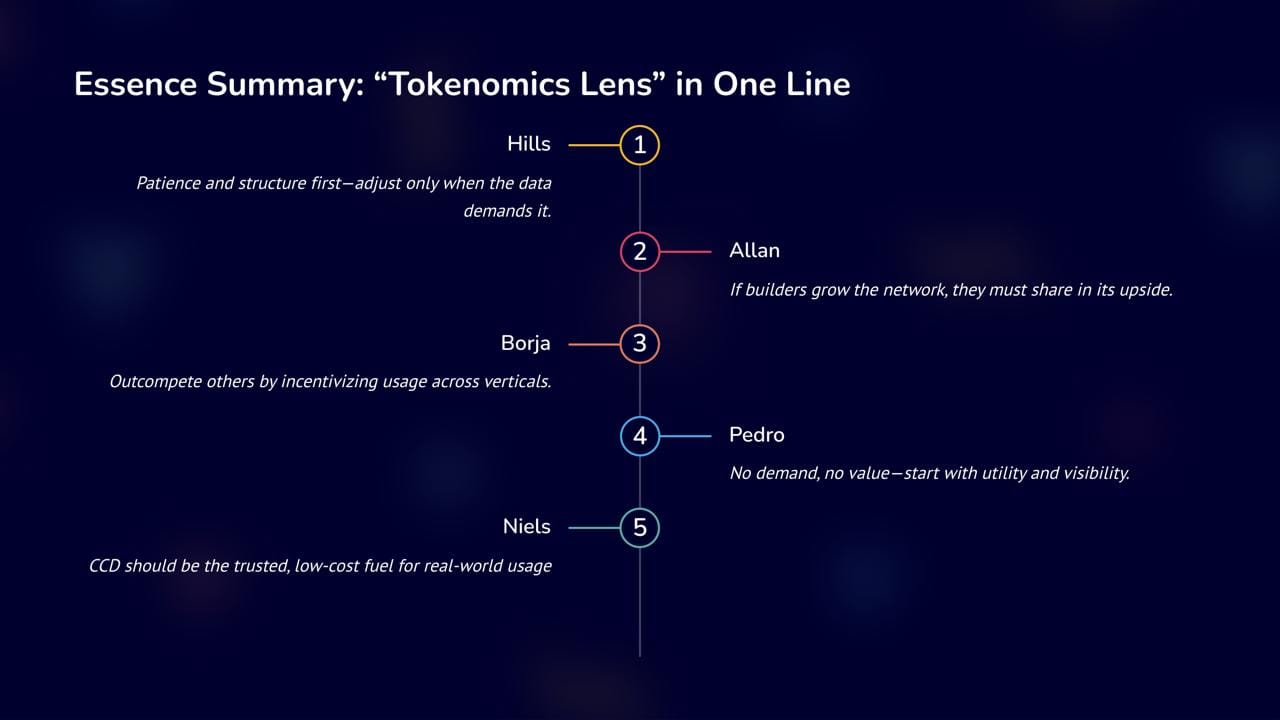
4 GOVERNANCE VISION
In this section, candidates reflect on how Concordium’s Governance Committee (GC) can evolve, from a compliance-focused steward into a proactive enabler of growth. Beyond protocol proposals and vote counts, governance must be transparent, inclusive, and responsive to the ecosystem’s actual builders and users. How do we bring in more voices, surface real-world needs, and turn governance into a catalyst rather than a bottleneck?
4.1 Allan Pedersen, CEO Eurodollar
- Allan believes a productive token economy will naturally result in stronger community engagement, especially when projects and companies (like Eurodollar) are economically linked to CCD.
- Cites his experience with MakerDAO, where radical transparency and open dialogue led to deeper community involvement and high-quality feedback.
- Argues that Concordium must adopt a similar model: the more transparent the GC and management are—sharing decisions, data, and rationales—the more people will contribute meaningfully.
- Praises the current management team’s progress in openness and sees this as a strong foundation to build on.
- Calls for sharing detailed, real-time insights into protocol developments and governance processes to unlock “magic-level” community participation.
- Believes that data access and communication frequency are essential levers to grow involvement across all stakeholder groups.
4.2 Borja Burguillos, Founder, 5Stars.io & AEDX
- Borja believes decentralizing governance requires more than voting—it demands informed, participatory leadership.
- Proposes forming thematic working groups across verticals (e.g., PayFi, gaming, identity, RWAs), enabling domain experts and builders to collaboratively refine proposals before governance votes.
- Suggests implementing a transparent treasury framework with KPI-linked outcomes, especially for grants—ensuring funding flows to projects that drive adoption, volume, and value.
- Argues governance should evolve into a catalyst for ecosystem growth, not a gatekeeping mechanism.
- Warns against GC becoming a bottleneck—calls for an agile, builder-oriented approach that supports experimentation and real-world deployment.
- Envisions GC as enabler of ideas like CCD as a stablecoin settlement layer or identity-based applications (e.g., age-gated games, on-chain credit), all driven by real builders.
- Goal: Attract top-tier talent by showing that Concordium is a place where builders are empowered, not slowed down.
4.3 Pedro Borges, CEO & Co-Founder, Criptoloja
- Pedro agrees strongly with both Allan’s call for transparency and Borja’s emphasis on structural participation.
- Stresses that governance must be built on open, continuous communication, not just between Concordium and the community—but also from the community back to Concordium.
- Suggests creating dedicated communication channels where real-world operators and builders can raise issues that impact adoption, such as:
- Compliance obstacles
- UX frictions
- Integration challenges
- Believes enabling two-way feedback is crucial for responsive governance that evolves with ecosystem needs.
4.4 Jareau van den Heuvel (“Hills”), Community Veteran
- Hills agrees with the emphasis on transparency and communication, but adds that true decentralization is also about building culture.
- Says that while the technical roadmap toward decentralization exists, cultural decentralization can only be achieved by engaging the community consistently and meaningfully.
- Highlights tools already in place—like Town Halls and open Q&As—as important for building trust and keeping the dialogue alive.
- Argues that the GC must not just speak, but listen, and create a space where community members feel heard and involved.
- Calls for GC members to act as visible and accountable representatives, not just decision-makers.
- Emphasizes that decentralization also means diverse representation—not for appearance, but because different roles (validator, builder, long-term holder) bring fundamentally different insights.
- Bottom line: The strength of governance lies in its inclusiveness, openness, and willingness to reflect the real ecosystem.
4.5 Niels Sørensen CEO & Co-founder Provenance Tags
- Argues that decentralization must include active participation, not just technical distribution.
- Calls for use-case-specific working groups to offer structured input to the GC—particularly from those building at scale.
- Urges inclusion of ecosystem projects and infrastructure partners early in roadmap discussions, not post-decision.
- Proposes dedicated roles or channels for builders, validators, and core contributors to ensure ongoing engagement.
- Supports full transparency around proposals, feedback, and how community input influences decisions.
- Stresses the need for a clear, repeatable process to surface real-world constraints and priorities from the field.
- Believes governance must evolve in parallel with adoption—especially as Concordium scales into regulated sectors like logistics, payments, and compliance.
- Bottom line: For governance to serve real-world builders, it must be accessible, accountable, and grounded in operational reality.
4.6 Comparison Matrix
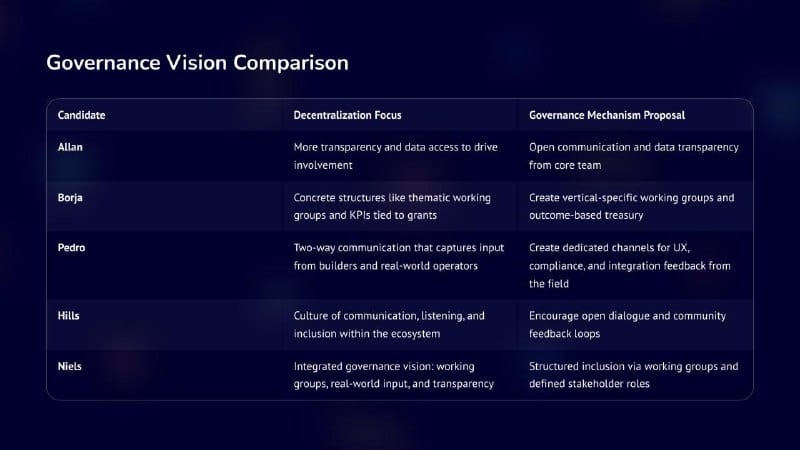
4.7 One-Liners
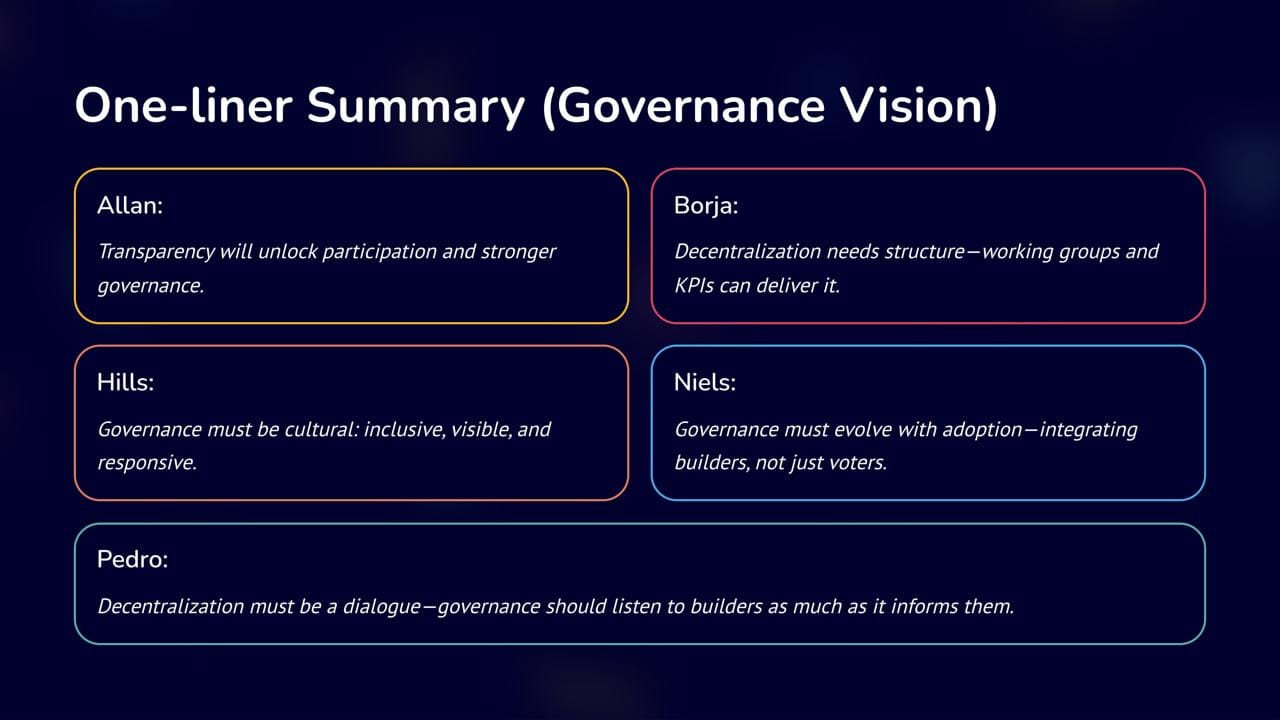
5 CLOSING REMARKS
In their final words, each candidate distills their vision and values into a simple message to voters. From pragmatic execution to community representation, from strategic clarity to real-world traction, their closing remarks offer a last reminder of what they stand for.
As Hills emphasized, this is not a zero-sum election. Approval voting means you can endorse multiple candidates you trust to guide Concordium forward. So vote your conviction, support those whose values, experience, and focus resonate with the future you want to build.
5.1 Borja Burguillos: Strategic clarity & builder inclusion
- Emphasizes that if elected, his top priority will be to bring strategic clarity to Concordium, focusing on identity, compliance, and real-world use cases.
- Wants to grow the ecosystem by supporting projects aligned with Concordium’s core strengths, and to expand participation through thematic working groups and feedback channels.
- Highlights the need to attract not just current builders, but new ones entering Web3 and PayFi who are seeking clarity, structure, and opportunity.
- Message: Governance must provide direction. Let’s focus, build, and attract.
5.2 Pedro Borges: Bridging Web3 ideals and regulatory realities
- Says he’s genuinely enjoying the process and wants to help Concordium fulfill its unique potential as a bridge between decentralized technology and real-world regulation.
- Believes the Governance Committee should reflect both Web3 values and pragmatic compliance insights drawn from his experience in regulated finance.
- Message: Help governance stay grounded in both vision and real-world constraints.
5.3 Hills: A seat for the community at the table
- Positions himself as the candidate who listens, connects, and represents the community voice at the GC table.
- Invites anyone with questions or advice to reach out via X or Telegram.
- Message: If you want the community heard, I hope to earn your vote.
5.4 Allan Pedersen: Alignment, realism, and execution
- Believes all candidates are broadly aligned on the plan: prioritize flagship use cases, scale from there, and align economics and transparency accordingly.
- Says that regardless of who gets elected, following this roadmap will lead to success.
- Offers his own strength as someone with deep institutional finance experience, particularly relevant if PayFi and stablecoins are key to the future.
- Message: I support the shared direction—if elected, I’ll help execute it pragmatically.
5.5 Niels Sørensen: A seat at the table for real-world builders
- States clearly that he’s running to ensure builders who deploy in regulated, high-value industries are meaningfully represented in governance.
- Acknowledges that others bring strong protocol and tokenomics knowledge, but emphasizes his own track record of building at scale on Concordium, running validator infrastructure, and operating in real-world sectors.
- Believes Concordium can become a top-10 Layer 1, but only if governance, tokenomics, and adoption are aligned around practical, field-tested realities.
- Message: Let’s grow Concordium—on-chain and in the real world.
5.6 Comparison Matrix
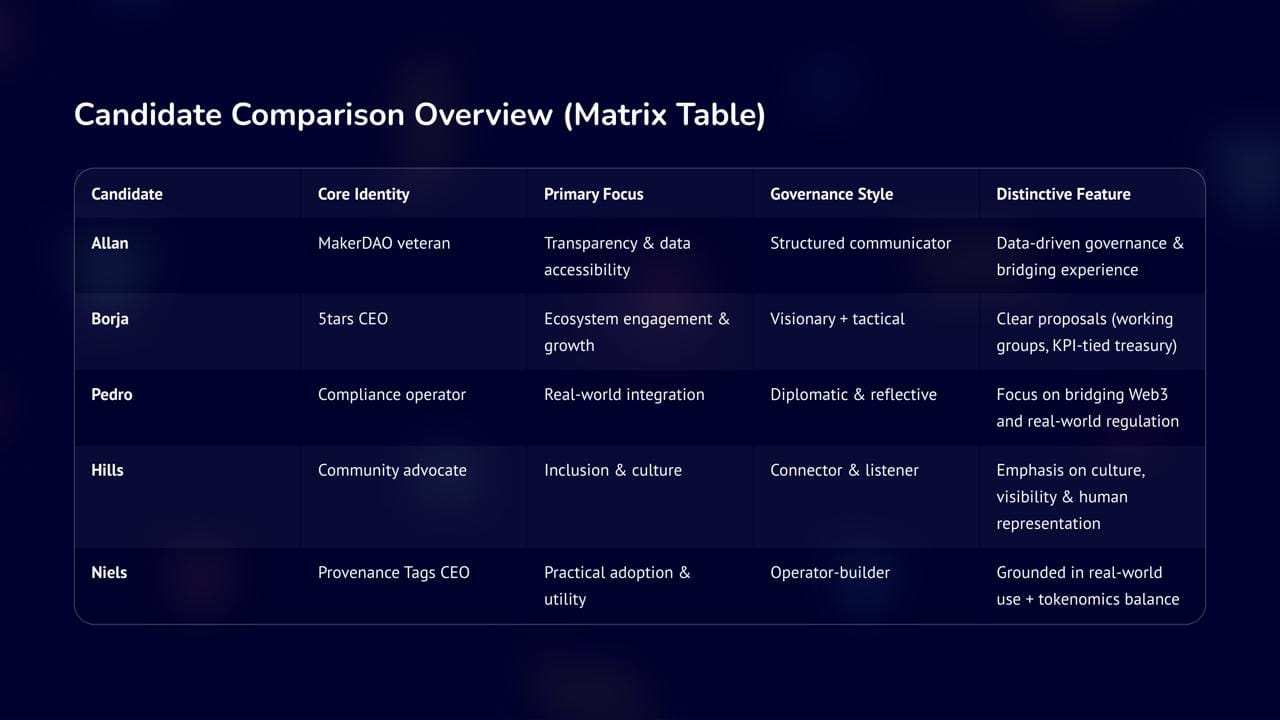
5.7 Key Themes and Points of Convergence
